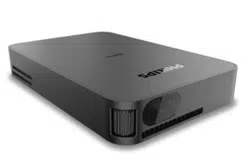Loading ...
Loading ...
Loading ...

Connect 98 Philips · GoPix 1 GPX1100
Image shape correction
Auto correction (vertical keystone)
The projector can automatically correct the
image to be rectangular when you tilt the
projector upwards or downwards.
To enable auto keystone correction, press
on remote control to access the settings menu,
then navigate to select Auto Keystone - On.
Manual correction
You can manually correct keystone or distorted
images to be rectangular.
1 Make sure you have selected Auto Keystone
- Off to enable this function.
2 Press
on the remote control to access
the settings menu, then navigate to select
Manual Keystone.
3 Press the Navigation buttons to adjust the
image shape.
Placement options
You can install the projector in the following
configurations. Follow the guidelines below for
different projector placement.
Notice
For overhead mounting on ceiling,
purchase a projector mount
recommended by an installation
professional and follow the instructions
that come with the mount.
Before mounting on the ceiling, make
sure the ceiling can support the weight
of the projector and mounting kit.
For ceiling installation, this product
must be securely attached to the ceiling
in accordance with the installation
instructions. An improper ceiling
installation may result in accident, injury
or damage.
Front table
1 Place the projector on a table in front of the
projection screen. This is the most common
way to position the projector for quick
setup and portability.
2 To adjust projection to the correct position,
press
on remote control to access the
settings menu, then navigate to select
Projection Mode - Rotate Front, then press
OK.
Front ceiling
1 Mount the projector on the ceiling with
upside up in front of the projection screen.
A projector mount is required to mount the
projector on ceiling.
2 To adjust projection to the correct position,
press
on remote control to access the
settings menu, then navigate to select
Projection Mode - Rotate Ceiling, then
press OK.
Rear table
1 Place the projector on a table behind the
projection screen. A special rear projection
screen is required.
2 To adjust projection to the correct position,
press
on remote control to access the
settings menu, then navigate to select
Projection Mode - Rotate Rear, then press
OK.
Rear ceiling
1 Mount the projector on ceiling with upside
up behind the projection screen. To mount
the projector on ceiling behind the screen,
a projector mount and a special rear
projection screen is required.
2 To adjust projection to the correct position,
press
on remote control to access the
settings menu, then navigate to select
Projection Mode - Rotate Rear Ceiling, then
press OK.
Using tripod
The projector comes with a tripod which allows
more choices for placing the projector.
Locate the tripod socket on the bottom of the
projector, then mount and secure the projector
on the tripod.
4 Connect
Notice
You need to connect the projector to
an HDMI or USB-C device, so that the
projection screen can show images.
Make sure all devices are disconnected
from the power outlet before establishing
or changing any connections.
Connect to devices through
HDMI
Connect a playback device (e.g. a Blu-ray
player, gaming console, camcorder, digital
camera or PC) to the projector through HDMI
connection. With this connection, images are
shown on the projection screen, and audio is
played on the projector.
1 Using the HDMI cable, connect the
connector on the projector to
the HDMI output on the playback device.
USB-C
Power
USB-C
Video
Mini
HDMI
You can also connect an iPhone to the
projector. Using the HDMI cable, connect
the connector on the projector
to the HDMI port on the Apple Digital AV
Adapter (not included). Then connect the
lightning connector of the adapter to your
iPhone.
Loading ...
Loading ...
Loading ...
